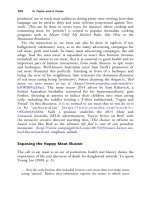The palgrave international handbook of a 326
Bạn đang xem bản rút gọn của tài liệu. Xem và tải ngay bản đầy đủ của tài liệu tại đây (27.36 KB, 1 trang )
324
J.E. Mazurek
and comfort of the pets in our stores. However, if your pet becomes ill during
this initial 14-day period, or if you’re not satisfied with your pet for any reason,
PetSmart will gladly replace the pet or refund the purchase price. Please keep
your sales receipt and return the pet to the store where it was purchased if
needed. (Petsmart 2015).
Overall, the US demand for marine aquarium pets is fuelled by approximately one million hobbyists in a trade wrought with systematic instances of
individual animal abuse as well as major environmental destruction and
ecological disorganization. At the individual level, given the relative inability
to distinguish recognizable cues of potential suffering in individual fish, it is
important to illustrate types of abuse that may easily be overlooked. Table 1,
adapted from Huntingford and colleagues (2006, pp. 356–358), indicates a
range of specific instances of potential animal abuse throughout the treadmill
of production inherent in not only the marine aquarium trade, but also
applicable to those fish stored in public aquariums.
At the level of ecological disorganization, over the past two decades, the
consumption preferences of aquarium hobbyists have increasingly moved toward
ecosystems mimicking the aesthetic of full reefs, versus fish-only tanks. This
consumption pattern has resulted in the commodification and abduction of
both fish and the coral habitat in which they live, ‘with a premium on both
biodiversity and scarcity [where] critical ecological roles are particularly vulnerable’
(Rhyne et al. 2012, p. 1; see also Rhyne et al. 2009). Both coral and fish specimens
are primarily extracted in Southeast Asia with a significant amount of coral being
extracted from China and the vast majority of both coral and fish extracted from
the Coral Triangle area (primarily from Indonesia and the Philippines but
including Malaysia, Papua New Guinea, the Solomon Islands, and Timor
Leste). The Coral Triangle is the most biologically diverse marine ecosystem in
the world and ‘the most seriously threatened, with 40 % of reefs effectively lost,
45 % under threat, and 15 % at low threat’ due to a combination of local and
global environmental factors (Hoegh-Guldberg et al 2009, pp. 5–6).
Coral habitat broadly serves in the most critical ecological role for countless marine species including fish, but the trade in coral has been profoundly
3
The Convention on International Trade in Endangered Species of Wild Fauna and Flora (CITES) is
an international trade agreement between 181 nations designed to regulate the trade in plant and animal
species so that such trade does not result in extinction. CITES covers 5,600 animal and 30,000 plant
species through three Appendices: Appendix I species are threatened by extinction (international trade in
such species is prohibited, but there are exemptions); Appendix II species are not yet threatened by
extinction but ‘may become so unless trade is closely monitored’; and Appendix III species are protected
by at least one CITES member country that asks other member countries to help control the international trade in that species (CITES 2015).









